Advertisements
Advertisements
प्रश्न
What is Resistivity?
उत्तर
The resistivity of a conductor is defined as the resistance of a conductor of unit length and unit area of cross-section.
APPEARS IN
संबंधित प्रश्न
Find the resistance of a conductor if 0.24 A current is passing through it and a potential difference of 24 V is applied across it.
Graph showing the variation of current versus voltage for a material Ga As is shown in the figure. Identify the region of
(i) negative resistance
(ii) where Ohm's law is obeyed.

Will current flow more easily through a thick wire or a thin wire of the same material, when connected to the same source? Why?
Let the resistance of an electrical component remains constant while the potential difference across the two ends of the component decreases to half of its former value. What change will occur in the current through it?
Why are coils of electric toasters and electric irons made of an alloy rather than a pure metal?
When a 12 V battery is connected across an unknown resistor, there is a current of 2.5 mA in the circuit. Find the value of the resistance of the resistor.
Find the expression for the resistivity of a material and state the SI unit of resistivity.
Keeping the p.d. constant, the resistance of a circuit is halved. The current will become:
(a) one-fourth
(b) four time
(c) half
(d) double
The graph between V and I for a conductor is a straight line passing through the origin.
Which law is illustrated by such a graph?
How should the two resistances of 2 ohms each be connected so as to produce an equivalent resistance of 1 ohm?
Which of the following is an ohmic resistance?
In a conductor 6.25 × `10^16` electrons flow from its end A to B in 2 s. Find the current flowing through the conductor (e = 1.6 × `10^-19` C)
An electric bulb draws 1.2 A current at 6.0 V. Find the resistance of filament of bulb while glowing.
Show by a diagram how two resistors R1 and R2 are joined in parallel. Obtain an expression for the total resistance of the combination.
A wire has a length of 2.0 m and a resistance of 5.0 Ω. Find the electric field existing inside the wire if it carries a current of 10 A.
How does an increase in the temperature affect the specific resistance of a :
(i) Metal and
(ii) Semiconductor ?
State the relation correlating the electric current flowing in a conductor and the voltage applied across it. Also, draw a graph to show this. relationship.
What is non-ohmic resistor?
Define Current density.
State macroscopic form of Ohm’s law.
What is ohmic device?
Define temperature coefficient of resistance.
Obtain the macroscopic form of Ohm’s law from its microscopic form and discuss its limitation.
An electronics hobbyist is building a radio which requires 150 Ω in her circuit, but she has only 220 Ω, 79 Ω, and 92 Ω resistors available. How can she connect the available resistors to get the desired value of resistance?
Consider a current carrying wire (current I) in the shape of a circle. Note that as the current progresses along the wire, the direction of j (current density) changes in an exact manner, while the current I remain unaffected. The agent that is essentially responsible for is ______.
A metal rod of length 10 cm and a rectangular cross-section of 1 cm × `1/2` cm is connected to a battery across opposite faces. The resistance will be ______.
State Ohm's Law. Represent it mathematically.
You are provided with a resistor, a key, an ammeter, a voltmeter, four cells of 1.5 V each and few connecting wires. Using circuit components, draw a labelled circuit diagram to show the setup to study Ohm's law.
State the relationship between potential difference (V) across the resistor and the current (I) flowing through it. Also draw V-I graph, taking V on the X-axis.
Let the resistance of an electrical device remain constant, while the potential difference across its two ends decreases to one fourth of its initial value. What change will occur in the current through it? State the law which helps us in solving the above stated question.
What is meant by resistance of a conductor ? Define its SI unit.
The resistance of a resistor is reduced to half of its initial value. If other parameters of the electrical circuit remain unaltered, the amount of heat produced in the resistor will become ______.
The voltage - current readings of a certain material are shown in the table given below:
| Voltage (V) | 10 V | 20 V | 30 V |
| Current (I) | 2 A | 3 A | 4 A |
Study the table.
- State whether the conductor used is ohmic or non-ohmic.
- Justify your answer.
- State Ohm's law.
